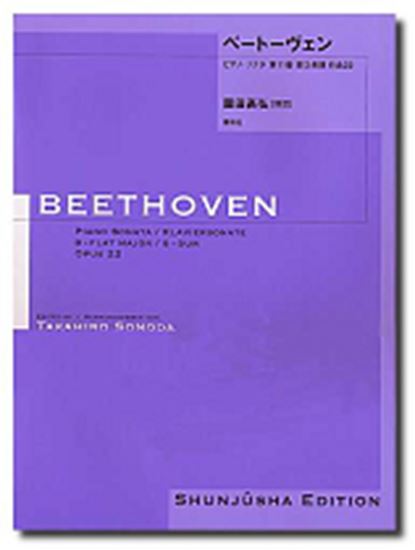Beethoven, Ludwig van : Sonate für Klavier Nr.11 B-Dur Op.22
Work Overview
Music ID :
423
Composition Year:1800 Publication Year:1802
First Publisher:Hoffmeister
Instrumentation:Piano Solo
Genre:sonata
Total Playing Time:24 min 30 sec
Copyright:Public Domain
Commentary (1)
Author : Okada, Akihiro
Last Updated: February 1, 2009
[Open]
Author : Okada, Akihiro
Last Updated: February 1, 2009
[Open]
Note: This article is automatically translated from the original Japanese text. The author of the original work did not supervise this translation.
This sonata, completed in 1800, was long believed to have been commenced in 1799, but recent scholarship suggests that its composition also began in 1800. It is Beethoven's last work composed while still adhering to the traditional framework of the sonata, despite his various experimental attempts. In his next work, Op. 26, he took a new step by eliminating the sonata-form movement itself.
I. B-flat Major, 4/4 time, Sonata Form
Exposition
- The principal theme consists of a light, ascending staccato motive and a legato, stepwise descending motive.
- After a transition reminiscent of a string ensemble reduction, featuring bass ostinato and chordal tremolos, leaping legato thirds in the upper voices, and scales or repeated seconds in the lower voices, the subordinate theme appears in F major (mm. 31–).
- The subordinate theme is presented in parallel thirds spanning two octaves, with an accent placed on the third beat.
- Following a transitional passage with arpeggiated figures and octave tremolos, the codetta features a resolute four-octave unison ascending and descending stepwise motion, after which a motive from the principal theme briefly emerges.
Development and Recapitulation
- The development unfolds with the principal theme's motive and the unison motive from the codetta appearing alternately.
- The principal theme's motive dissolves into arpeggiated figures, and a scale passage, seemingly developed from the codetta's unison motive, leads into the recapitulation.
- In the recapitulation, both the principal and subordinate themes appear in the tonic key (B-flat major), and the movement concludes directly with a coda that is not expanded.
II. E-flat Major, 9/8 time
- This is an Adagio slow movement where ornamental passages unfold over a sustained chordal accompaniment. It features two themes: one in E-flat major and another in the dominant key of B-flat major.
- In the middle section (mm. 31–), motives from the first theme are developed, and in the latter half (mm. 47–), both themes are recapitulated in the tonic key of E-flat major.
- This tonal plan and structural organization are remarkably close to sonata form, suggesting an attempt to incorporate sonata form into a slow movement.
III. B-flat Major – G minor, 3/4 time, Menuetto
- Although a dance-form movement, this work features a Menuetto rather than a Scherzo. The main section of the Menuetto is constructed with dotted rhythms and ornamental figures featuring appoggiaturas. The middle section, the Trio, is marked Minore and modulates to the parallel key of G minor. It is characterized by continuously moving sixteenth-note figures and chordal motives with an accent on the second beat.
IV. B-flat Major, 2/4 time, Rondo
- The light and agile rondo theme features a continuously sustained dominant note (F) in the inner voice. After an arpeggiated transitional passage, a syncopated octave theme appears in B-flat Major (mm. 25–). Following an arpeggiated transitional idea, a motive from the rondo theme is repeated, and the rondo theme returns (mm. 50–).
- The subsequent section, where a new theme would typically be presented in rondo form, is instead dedicated to the development and elaboration of existing material (mm. 68–). The recapitulation of the rondo theme (mm. 120–) also incorporates considerable variation techniques. After the recapitulation of the dominant theme, the rondo theme appears once more, and the piece concludes with a coda that further develops the motives.
Writer:
Okada, Akihiro
Movements (4)
2.Satz Adagio con molta espressione
Total Performance Time: 9 min 00 sec
PTNA & Partner Channel Videos(10items) View More
- favorite_border
- 0
Performer(s):
Tsuno, Ayane
Recording Date: 2025/8/19
Recording Location: 第一生命ホール(2025年ピティナ・ピアノコンペティション特級セミファイナル)
Recording Date: 2025/8/19
Recording Location: 第一生命ホール(2025年ピティナ・ピアノコンペティション特級セミファイナル)
- favorite_border
- 0
Performer(s):
Tsuno, Ayane
Recording Date: 2025/8/19
Recording Location: 第一生命ホール(2025年ピティナ・ピアノコンペティション特級セミファイナル)
Recording Date: 2025/8/19
Recording Location: 第一生命ホール(2025年ピティナ・ピアノコンペティション特級セミファイナル)
- favorite_border
- 0
Performer(s):
Tsuno, Ayane
Recording Date: 2025/8/19
Recording Location: 第一生命ホール(2025年ピティナ・ピアノコンペティション特級セミファイナル)
Recording Date: 2025/8/19
Recording Location: 第一生命ホール(2025年ピティナ・ピアノコンペティション特級セミファイナル)
- favorite_border
- 0
Performer(s):
Tsuno, Ayane
Recording Date: 2025/8/27
Recording Location: 第一生命ホール(2025年ピティナ・ピアノコンペティション特級セミファイナル)
Recording Date: 2025/8/27
Recording Location: 第一生命ホール(2025年ピティナ・ピアノコンペティション特級セミファイナル)
Performer(s):
Minami, Kotoko
Recording Date: 2023/8/20
Recording Location: 第一生命ホール(2023年ピティナ・ピアノコンペティション Pre特級全国決勝大会)
Recording Date: 2023/8/20
Recording Location: 第一生命ホール(2023年ピティナ・ピアノコンペティション Pre特級全国決勝大会)
Sheet Music
Scores List (12)

ベートーヴェン集1 ソナタ集1
(株)春秋社
(株)春秋社

ベートーベン ソナタ・アルバム 1
(株)全音楽譜出版社
(株)全音楽譜出版社

ベートーヴェン ピアノソナタ全集 1 (リスト編) BEETHOVEN*ベートーベン
(株)全音楽譜出版社
(株)全音楽譜出版社

ベートーヴェン ピアノ・ソナタ集 1 (トーヴィ編) BEETHOVEN*ベートーベン
(株)全音楽譜出版社
(株)全音楽譜出版社

ベートーヴェン : ピアノ・ソナタ集 第1巻/原典版 : 第1番~第15番
ヘンレ社(ヤマハ)
ヘンレ社(ヤマハ)

ウィーン原典版107 ベートーヴェン ピアノ・ソナタ集1
(株)音楽之友社
(株)音楽之友社

BEETHOVEN Complete Sonatas for Pianoforte 2
Barenreiter
Barenreiter







![ベートーヴェン・ピアノ作品集2 ソナタ集[歴史的注解付批判校訂版] - 楽譜表紙画像](https://ptna-assets.s3.ap-northeast-1.amazonaws.com/enc/books/127.jpg)



